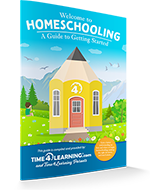What, When, Why & How of Deschooling
The term “deschooling” arose over time as more and more public school students began the transition to homeschool. On this page you will learn more about the process of transitioning from public school to homeschool, why students doing this need a period of time to make that transition (deschooling), and how to continue the transition to a more formal habit of homeschooling.
What Is Deschooling?
Deschooling involves a period where you do very little formal school work in order to re-calibrate your child’s natural love of learning. During the deschooling process you’ll adjust your understanding of, and approach to, how a child learns. Because public and private education is focused on educating multiple students at once, it can take parents and students time to recognize how different homeschooling is in comparison. The following chart illustrates just some of the major differences between classroom instruction and learning in a homeschool environment.
Classroom vs. Homeschool Learning
Parents and students who have experienced classroom learning as the “norm” will need some time to adjust to a vastly different way of learning. So what is deschooling in education going to mean for a homeschooler? When the focus is less on classroom management, and more on helping your child reach his or her specific learning goals, the educational process is much more individualized. A period of deschooling prior to jumping right into homeschooling helps both students and parents make this shift.
| Learning in a Classroom | Learning in a Homeschool |
|---|---|
|
|
How Long Does Deschooling Take?
Despite what you may read, there are no hard or fast rules for how long it takes for previously public or private schooled children to adjust to a more flexible, customized, and wholly different approach to education. However, the longer your child was previously in school, the longer it may take them (and you!) to embrace learning for learning’s sake.
If your child feels bored during this time, or is struggling with the lack of structure, it’s fine to integrate some fun learning activities such as educational field trips, and to incorporate some engaging lessons that will keep your child’s brain active during the deschooling period. Time4Learning is an excellent deschooling tool because it’s completely flexible and able to be used when and how parents and students wish. Families can pick and choose the lessons and activities they want to use and even tie in the Time4Learning lessons with other hands-on adventures and day trips they are involved in. Time4Learning works as the ideal enrichment program while families are decompressing and reevaluating their learning plan.
For more information on deschooling visit A2Z Homeschooling’s Deschooling Page
Switching from Public School to Homeschooling
For innumerable reasons, families often have to pull a child from public or private school to begin teaching that child at home. Reasons parents and children make this move can include:
- A physical or mental health issue that necessitates time away from the classroom
- A poor fit between a child and a teacher/class/school
- A child’s academic needs not being adequately met within his/her current school
- Excessive bullying or other safety concerns within a school environment
- A desire to focus on a specific dream a child wants to pursue such as Olympic competition, acting, or an entrepreneurial pursuit
- To give a child/teen a more customized, flexible, and diverse educational experience
The decision of leaving public school to homeschool requires a major adjustment on the part of both parents and students. It is more than an educational shift; it is a life adjustment! That’s where a period of deschooling comes in.
Tips for Student Activities During Deschooling Period
To help your student shift gears from traditional schooling to homeschooling, it’s important to give them time to decompress during this period of transition. Below are some tips to get your child into the homeschooling frame of mind.
- Find a homeschool group, whether it’s a virtual group or an actual facility where family’s meet. This will allow them to make new friends and get them excited about this new adventure. Plus the support and encouragement they receive will reassure them that homeschooling will be fun and do them a world of good.
- Become more familiar with your local library. Introduce yourself to the librarian and get to know him or her. They can be such a great source of information when it comes to books, reading lists, and reading programs. Plus, many libraries host weekly story times, arts and crafts, teen clubs, book fairs, and more. There are also tons of reference materials like encyclopedias, magazines, and DVDs you can borrow.
- Physical activity is a good thing for both the body and mind. It can help eliminate boredom, reduce stress, and allow your child to blow off some steam. Let your child decide how to use their time, whether it’s by jumping rope, doing yoga, or playing catch outside. Giving them a little control over their own time can help promote and encourage the independent learning that comes with homeschooling.
Transitioning from Deschooling to Homeschooling
How do you know when you and your children have had a long enough period of deschooling? That point probably comes when you can answer each of the following with a definite (or at least a more confident) “Yes.”
- Do I recognize that learning can happen at any time, and in any location?
- Do I understand that every child learns differently, and that my homeschooler has specific learning preferences, or learning styles?
- Do I grasp the freedoms that families have to customize their child’s education?
- Do I see my child’s curiosity about something as a natural jumping-off point for a learning experience?
- Have you and your children begun to “reconnect” with each other?
- Are you beginning to appreciate the value of supplemental activities such as field trips, clubs, and athletics for a well-rounded homeschool education?
After deschooling, what comes next? Well, welcome to homeschooling! You can begin to gradually add in some more structure to your days, if that is something that helps you and your children learn more effectively. You’ll begin to find your rhythm and preferred homeschool style. You will probably (if you haven’t already) begin to connect with local homeschool groups in your area. You will choose the best mix of curriculum and materials that fit your overall educational goals.
Shedding your previous understanding of how children learn allows you to embrace a much more holistic and personalized educational approach. Certainly, you will fall back on old habits and ideas from time to time, but when your eyes are fully open to the true freedom and flexibility of homeschool, you may never want to look back!
Welcome to Homeschooling Guide
Download this FREE resource where experienced homeschoolers share their stories for how to begin homeschooling, understanding your child academically, planning your days, and much more.







